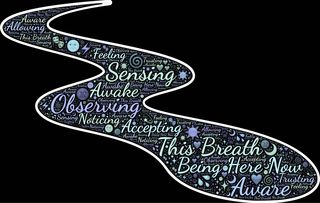
Yoga is ubiquitous in American culture today, recognized as invaluable by many to maintain health and fitness; yet many remain unaware of the very meaning of the word of “yoga,” less the richness of its practice. Western culture has extracted physical exercise of yoga, which is, in actuality, only part of its signficance. Given the depth of the yoga tradition, practitioners and onlookers may find it worthy to consider the relevance of the various limbs of yoga.
Yoga’s roots have been traced back 5,000 years as referenced in ancient Indian texts, including the Bhagavada Gita, the Yoga Sutras, and the Upanishads, which form the base of Hinduism (Feuerstein, 2006). Derived from the Sanskrit word “to yoke" and "to unite,” uniting body, mind, and spirit (Chopra & Simon, 2004), the word yoga literally means “to unite with God.”

In its fullness, yoga is an integrative, holistic experience of body, mind, and soul, drawing out physical, mental, meditative, and existential engagement. While most American practitioners delve into yoga’s physical exercises, focusing on various poses and, sometimes, introductory meditative techniques, engagement of the wider tradition may open the door to rich dimensions and, potentially, a transformational experience.
In a typical health and fitness class, breathing or meditational exercises start the session to slow down metabolism and focus concentration, often enhanced by visualization and meditative music.

Relaxation exercises then follow to warm up, followed by stretching muscles to release tension and engaging in various degrees of physically challenging movements and poses, according to the capacity of the participants.
As yoga traditionally presented various adaptations, Pataniali compiled the Indian sacred texts, in 200 AD (Chopra, 2004), referencing its various embodiments as “The Eight Limbs of Yoga.” These eight branches of yoga provide a prescription for maintaining a balanced, whole life, uniting the physical, emotional, moral, social, and spiritual aspects of human nature. They include:
- Yama
- Niyama
- Asana
- Pranayama
- Prytyhara
- Dharana
- Dhyana, and
- Samadhi
Yama, the first limb, concerns ethical and social behaviors and engagement. The directives address honesty, generosity, nonviolence, and sexual restraint. The intention of this branch is to guide compassion and love, to awaken awareness of materialistic drives, and to teach of balance between enjoyment and spiritual aliveness.
Niyama, the second limb, supports guidelines for personal behavior. These instructions focus on personal spiritual growth to enhance self-discipline, purity, spiritual development, peace, and surrender to God. Personal discipline is key in Niyama, referencing routines for daily meditation, exercise, healthy diet, monitoring a positive environment, and trust in God.

Asana, the third limb, most closely aligns with yoga as practiced for health and fitness, focusing on stretching, posing, and exercises to enhance flexibility and muscle tone. In the Hindi tradition, Asana, moreover, engages attunement of the flow of energy in the body, resulting in a body-mind integration that enhances the capacity to concentrate and meditate. In the Hindu tradition, as represented in many religious traditions, the body is understood as a temple of the spirit; therefore, care of the body is required for spiritual growth and development.
Pranayma, the fourth limb, regards embodying awareness of “the life force,” defining the term “spirituality” through mastery of breathing. Pranayma guides the process for hearing our “inner voice,” our spiritual nature, increasing consciousness so that the exterior world does not distract from our true nature, the interior world of the self. This branch guides understanding between individuality and universality.
Pratyhara, the fifth limb, zeroes in on engagement of meditation to deepen awareness of our inner voice, and escape from apprehending life through sensate attention. This branch intensifies self-awareness so that we are attentive to our interior existence rather than led by temporal influences.

Dharana, the sixth stage, focuses concentration of mind. In this process of meditation, thinking slows down, through attention to a single object, and silent repetition of a sound or a mantra. Adaptations of this meditative process occur through modern meditation techniques (such as in the Relaxation Response—Benson, 1975), among various religious traditions, that direct focused, repetition on a religious objects or prayer (e.g., the cross, the star of King David, an icon, calligraphic representation of the word Allah; the Jesus prayer, etc.).
Dhyana, the seventh limb, identifies an advanced stage of concentration. This meditative state slows thinking from distraction to concentration upon a single object and stillness—without thoughts. One is enveloped in this state, characterized by attention to a specific energetic center of the body, God, or in a mantra. This branch culminates the three previous branches.

Samadhi, the eighth limb, equates to the goal of yoga—a state of peace, in pure, unbound awareness. This branch is an experience of tasting the realm of eternity and infinity—what Christians may refer to as “experiencing the Kingdom of God—within,” to know yourself as a spiritual being (a spirit) disguised as a human being. Yoga’s endpoint leads to this stage of union with God, where one performs actions in harmony with the evolving flow of life. Here, one participates in the world as an individual while simultaneously attuned to universal being.
There are more than 100 forms of yoga that seek awakening and awareness in the present moment to achieve wholeness (physical, emotional, moral, social, spiritual life)--enlightenment. While yoga emerges from the Hindu tradition, the wealth of its evident holistic and universal appeal finds adaptability to various cultures and religious traditions.
In modern times, a growing body of research suggests numerous positive physical and emotional outcomes that result from the Asana (exercise) branch of yoga alone (Patel, N. K., et al; Ross, et al., 2010; Novotney, 2009; Uebelacker, L. A., et al., 2010), often distinguishing itself from the wider practice of all eight limbs as discussed here.

Many engaging in the asana limb of yoga intentionally dissociate from the fuller yoga tradition, as they desire to engage only in physical exercise or do not seek to explore these wider applications. From the opposite perspective, the question may be raised about whether only practices of asana, the physical aspects of yoga, alone, accurately represents yoga. While this remains a matter of personal judgment or definition, for those unaware of the richness of the breadth of yoga and for those who may wish to expand their experience of this time-honored tradition, by engaging all eight limbs of yoga, the yoga participant benefits from potentially profound and deeper results toward self-awareness and holistic growth.
John T. Chirban, Ph.D., Th.D., is a lecturer, part-time, at Harvard Medical School and author of Collateral Damage: Guiding and Protecting Your Child Through the Minefield of Divorce (HarperCollins, 2017) and True Coming of Age (McGraw-Hill, 2004), among severals. For more information, visit drchirban.com.
References
Chopra, D. & Simon, D., 2004. The Seven Spiritual Laws of Yoga: A Practical Guide to Healing Body, Mind, and Spirit. Hoboken, NJ: John Wiley & Sons, Inc.
Feuerestein, G., 2006. A Short History of Yoga. Yoga Learning Center. Retrieved fromhttp://www.yogalearningcenter.com/articles/short_history_of_yoga.
http://www.yogalearningcenter.com/articles/short_history_of_yoga.
Novotney, A., 2009. Yoga as a practice tool. The American Psychological Association, 40(10). 38-40.
Patel, N.K., Newstead, A.H. and Ferrer, R.L., 2012. The effects of yoga on physical functioning and health related quality of life in older adults: a systematic review and meta-analysis. The Journal of Alternative and Complementary Medicine, 18(10), pp. 902-917.
Ross, A. and Thomas, S., 2010. The health benefits of yoga and exercise: a review of comparison studies. The Journal of Alternative and Complementary Medicine, 16(1), pp. 3-12.
Uebelacker, L.A., Epstein-Lubow, G., Gaudiano, B.A., Tremont, G., Battle, C.L. and Miller, I.W., 2010. Hatha yoga for depression: critical review of the evidence for efficacy, plausible mechanisms of action, and directions for future research. Journal of Psychiatric Practice®, 16(1), pp. 22-33.




